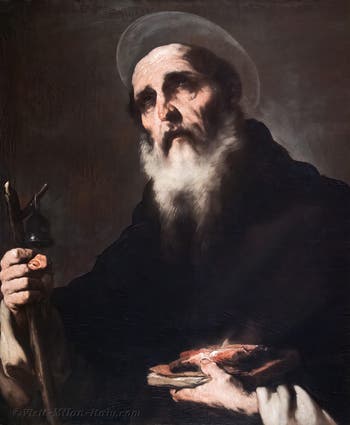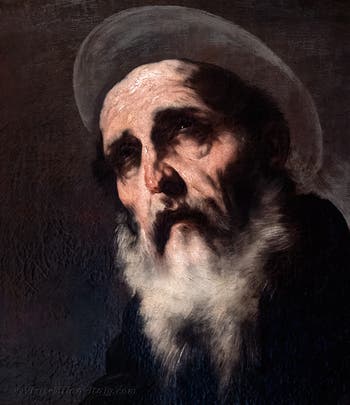Museums Ambrosiana | Castello Sforzesco | Poldi Pezzoli
Poldi Pezzoli Artists | Location | Opening Hours Tickets | Authorizations
Artists Bellini | Botticelli | Canaletto | Carriera | Cranach | Daddi | Francesca | Giordano | Titian | Guardi | Lippi F. | Lotto | Luini | Mantegna | Montagna | Memling | Palma | Pinturicchio | Pollaiolo | Raphael | Tiepolo | Titian | Weapons Room
Luca Giordano “Saint Anthony the Abbot” Poldi Pezzoli Museum in Milan in Italy
Luca Giordano (October 18, 1634 — January 3, 1705) “Saint Anthony Abbot”
Painting - Oil on Canvas (74.6 x 63.4 cm) 1650
Saint Anthony the Abbot Saint Anthony humbly looks up to the sky while holding his tau staff with one hand with a bell, which is one of his attributes.
On the other hand, he carries a book containing the smouldering embers of three pieces of wood, fiery firebrands.
Born in the Nile Valley, Saint Anthony (251-356) became a hermit by subjecting his body to asceticism to resist the temptations that tormented him in his youth.
He died at the age of 105, and although he requested that the location of his tomb be kept secret, his relics were found in the sixth century, which, after passing through Constantinople in 708, ended their journey in Arles.
In 1095, Gaston de Valloire and his son were victims of an epidemic and vowed to devote their lives to caring for the sick if they recovered, thanks to the relics of Saint Antoine.
After their recovery, they kept their word by creating the Order of Hospitallers.

Saint Anthony the Abbot Pope Calixtus II entrusted the relics of Saint Anthony to this new order in 1118.
The Hospitallers had the right to make the quest to treat the “internal fire”, later renamed “Saint Anthony's fire”.
This disease, which came from a fungus called ergot rye, caused spasms, hallucinations, vomiting, headache, and purulent wounds that could lead to gangrene.
The Antonines of the Order of the Hospitallers cared for the sick mainly with pork fat and, of course, with prayers.
In the event of gangrene, they were responsible for performing amputations.
Because of these healings attributed to Saint Anthony, he is often represented with hot coals or a fire corresponding to the “Saint Anthony's fire”.
Since pork fat was part of the treatments for the disease, sometimes a pig is also represented in the company of Saint Anthony.
Luca Giordano focused on the symbolism of the fiery teas on the sacred book carried by a praying healer, Saint Anthony, without referring to his carnal temptations.
The temptations of Saint Anthony were, however, amply represented in numerous works, including the famous engraving by Martin Schongauer, which inspired the young Michelangelo to create what is believed to be his first painting when he was still a student of Domenico Ghirlandaio.
A painting by Tintoretto located in the church of San Trovaso in Venice shows Saint Anthony almost naked, surrounded by naked women.
Artists Bellini | Botticelli | Canaletto | Carriera | Cranach | Daddi | Francesca | Giordano | Titian | Guardi | Lippi F. | Lotto | Luini | Mantegna | Montagna | Memling | Palma | Pinturicchio | Pollaiolo | Raphael | Tiepolo | Titian | Weapons Room
Poldi Pezzoli Artists | Location | Opening Hours Tickets | Authorizations
Museums Ambrosiana | Castello Sforzesco | Poldi Pezzoli
Back to Top of Page

